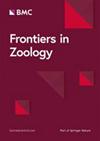共生带绦虫的胚后发育和生活方式转变
IF 2.6
2区 生物学
Q1 ZOOLOGY
引用次数: 0
摘要
生物之间的共生关系与各种形态适应有关。马拉科贝德拉属(Malacobdella)就具有这样的适应性。该属的所有物种都是软体动物宿主的共生体,通过末端吸盘附着在宿主的甲壳表面。Malacobdella 在单膜纲中具有几个独特的特征,表现出顶吸盘和无眼、无顶端/大脑器官,这与它们适应共生生活方式有关。然而,在它们从自由生活的幼虫过渡到共生成虫的过程中,产生这些形态特征的发育过程仍不确定。因此,在本研究中,我们利用荧光分子标记对胚后幼虫阶段内部形态的发育过程进行了可视化研究。我们展示了包括吸盘原基和功能吸盘形成在内的发育过程。此外,我们的数据还显示,包括顶端/大脑器官在内的感觉器官在胚胎和胚后早期阶段形成,但在胚后晚期阶段退化,然后利用顶端吸盘在宿主体内定居。这项研究揭示了顶吸盘是通过组织内陷形成的,并阐明了其粘附机制。吸盘肌肉的发育可能源自体壁肌肉。值得注意的是,M. japonica 虽然缺乏幼虫眼轴,但却表现出负趋光性。这一观察结果表明,其他感觉机制(如在幼虫体内发现的顶端器官和大脑器官)在促进沉降和粘附行为方面可能发挥作用。幼虫发育过程中感觉器官的丧失可能反映了从浮游觅食到稳定的宿主相关生活方式的过渡。这项研究还强调了进一步研究的必要性,以探索两棘鲷亚目内的系统发育关系,并研究密切相关类群的胚后神经肌肉系统发育,从而更全面地了解两棘鲷的生态适应性。本文章由计算机程序翻译,如有差异,请以英文原文为准。
Postembryonic development and lifestyle shift in the commensal ribbon worm
Various morphological adaptations are associated with symbiotic relationships between organisms. One such adaptation is seen in the nemertean genus Malacobdella. All species in the genus are commensals of molluscan hosts, attaching to the surface of host mantles with a terminal sucker. Malacobdella possesses several unique characteristics within the order Monostilifera, exhibiting the terminal sucker and the absence of eyes and apical/cerebral organs, which are related to their adaptation to a commensal lifestyle. Nevertheless, the developmental processes that give rise to these morphological characteristics during their transition from free-living larvae to commensal adults remain uncertain. In the present study, therefore, we visualized the developmental processes of the internal morphologies during postembryonic larval stages using fluorescent molecular markers. We demonstrated the developmental processes, including the formation of the sucker primordium and the functional sucker. Furthermore, our data revealed that sensory organs, including apical/cerebral organs, formed in embryonic and early postembryonic stages but degenerated in the late postembryonic stage prior to settlement within their host using a terminal sucker. This study reveals the formation of the terminal sucker through tissue invagination, shedding light on its adhesion mechanism. Sucker muscle development likely originates from body wall muscles. Notably, M. japonica exhibits negative phototaxis despite lacking larval ocelli. This observation suggests a potential role for other sensory mechanisms, such as the apical and cerebral organs identified in the larvae, in facilitating settlement and adhesive behaviors. The loss of sensory organs during larval development might reflect a transition from planktonic feeding to a stable, host-associated lifestyle. This study also emphasizes the need for further studies to explore the phylogenetic relationships within the infraorder Amphiporiina and investigate the postembryonic development of neuromuscular systems in closely related taxa to gain a more comprehensive understanding of ecological adaptations in Nemertea.
求助全文
通过发布文献求助,成功后即可免费获取论文全文。
去求助
来源期刊

Frontiers in Zoology
ZOOLOGY-
CiteScore
4.90
自引率
0.00%
发文量
29
审稿时长
>12 weeks
期刊介绍:
Frontiers in Zoology is an open access, peer-reviewed online journal publishing high quality research articles and reviews on all aspects of animal life.
As a biological discipline, zoology has one of the longest histories. Today it occasionally appears as though, due to the rapid expansion of life sciences, zoology has been replaced by more or less independent sub-disciplines amongst which exchange is often sparse. However, the recent advance of molecular methodology into "classical" fields of biology, and the development of theories that can explain phenomena on different levels of organisation, has led to a re-integration of zoological disciplines promoting a broader than usual approach to zoological questions. Zoology has re-emerged as an integrative discipline encompassing the most diverse aspects of animal life, from the level of the gene to the level of the ecosystem.
Frontiers in Zoology is the first open access journal focusing on zoology as a whole. It aims to represent and re-unite the various disciplines that look at animal life from different perspectives and at providing the basis for a comprehensive understanding of zoological phenomena on all levels of analysis. Frontiers in Zoology provides a unique opportunity to publish high quality research and reviews on zoological issues that will be internationally accessible to any reader at no cost.
The journal was initiated and is supported by the Deutsche Zoologische Gesellschaft, one of the largest national zoological societies with more than a century-long tradition in promoting high-level zoological research.
 求助内容:
求助内容: 应助结果提醒方式:
应助结果提醒方式:


